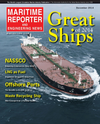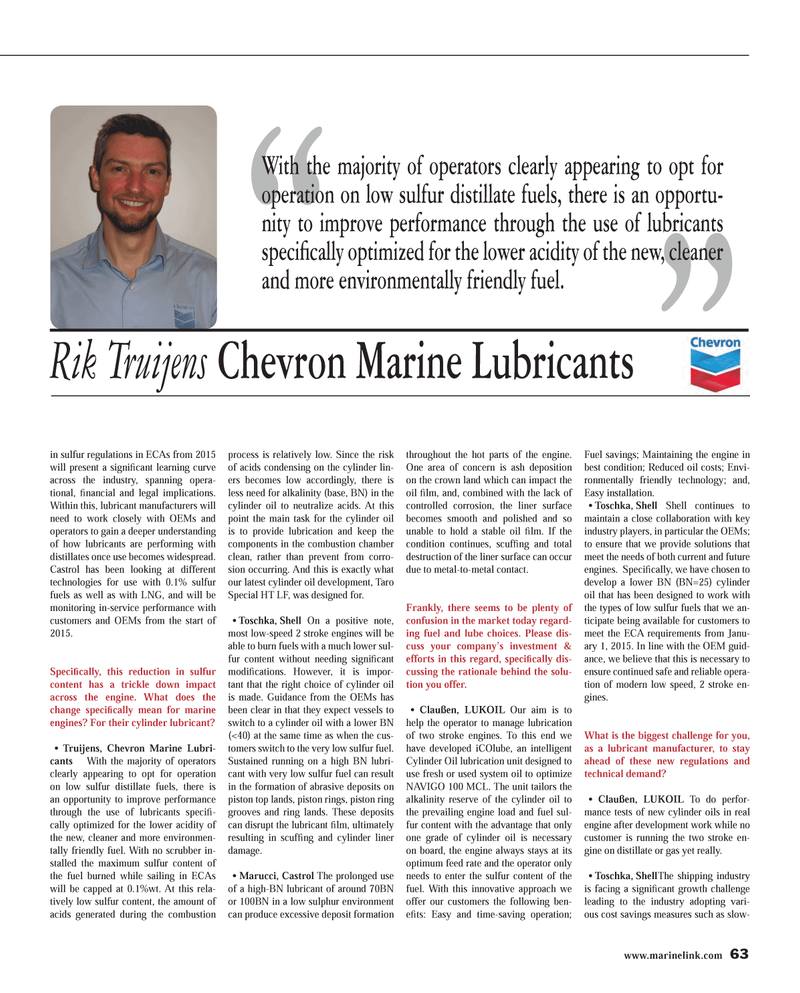
Page 63: of Maritime Reporter Magazine (December 2014)
Great Ships of 2014
Read this page in Pdf, Flash or Html5 edition of December 2014 Maritime Reporter Magazine
www.marinelink.com 63 ” “ in sulfur regulations in ECAs from 2015 will present a signifi cant learning curve across the industry, spanning opera- tional, fi nancial and legal implications.
Within this, lubricant manufacturers will need to work closely with OEMs and operators to gain a deeper understanding of how lubricants are performing with distillates once use becomes widespread.
Castrol has been looking at different technologies for use with 0.1% sulfur fuels as well as with LNG, and will be monitoring in-service performance with customers and OEMs from the start of 2015.
Specifi cally, this reduction in sulfur content has a trickle down impact across the engine. What does the change specifi cally mean for marine engines? For their cylinder lubricant? • Truijens, Chevron Marine Lubri- cants With the majority of operators clearly appearing to opt for operation on low sulfur distillate fuels, there is an opportunity to improve performance through the use of lubricants specifi - cally optimized for the lower acidity of the new, cleaner and more environmen- tally friendly fuel. With no scrubber in- stalled the maximum sulfur content of the fuel burned while sailing in ECAs will be capped at 0.1%wt. At this rela- tively low sulfur content, the amount of acids generated during the combustion process is relatively low. Since the risk of acids condensing on the cylinder lin- ers becomes low accordingly, there is less need for alkalinity (base, BN) in the cylinder oil to neutralize acids. At this point the main task for the cylinder oil is to provide lubrication and keep the components in the combustion chamber clean, rather than prevent from corro- sion occurring. And this is exactly what our latest cylinder oil development, Taro
Special HT LF, was designed for. • Toschka, Shell On a positive note, most low-speed 2 stroke engines will be able to burn fuels with a much lower sul- fur content without needing signifi cant modifi cations. However, it is impor- tant that the right choice of cylinder oil is made. Guidance from the OEMs has been clear in that they expect vessels to switch to a cylinder oil with a lower BN (<40) at the same time as when the cus- tomers switch to the very low sulfur fuel.
Sustained running on a high BN lubri- cant with very low sulfur fuel can result in the formation of abrasive deposits on piston top lands, piston rings, piston ring grooves and ring lands. These deposits can disrupt the lubricant fi lm, ultimately resulting in scuffi ng and cylinder liner damage. • Marucci, Castrol The prolonged use of a high-BN lubricant of around 70BN or 100BN in a low sulphur environment can produce excessive deposit formation throughout the hot parts of the engine.
One area of concern is ash deposition on the crown land which can impact the oil fi lm, and, combined with the lack of controlled corrosion, the liner surface becomes smooth and polished and so unable to hold a stable oil fi lm. If the condition continues, scuffi ng and total destruction of the liner surface can occur due to metal-to-metal contact.
Frankly, there seems to be plenty of confusion in the market today regard- ing fuel and lube choices. Please dis- cuss your company’s investment & efforts in this regard, specifi cally dis- cussing the rationale behind the solu- tion you offer. • Claußen, LUKOIL Our aim is to help the operator to manage lubrication of two stroke engines. To this end we have developed iCOlube, an intelligent
Cylinder Oil lubrication unit designed to use fresh or used system oil to optimize
NAVIGO 100 MCL. The unit tailors the alkalinity reserve of the cylinder oil to the prevailing engine load and fuel sul- fur content with the advantage that only one grade of cylinder oil is necessary on board, the engine always stays at its optimum feed rate and the operator only needs to enter the sulfur content of the fuel. With this innovative approach we offer our customers the following ben- efi ts: Easy and time-saving operation;
Fuel savings; Maintaining the engine in best condition; Reduced oil costs; Envi- ronmentally friendly technology; and,
Easy installation. • Toschka, Shell Shell continues to maintain a close collaboration with key industry players, in particular the OEMs; to ensure that we provide solutions that meet the needs of both current and future engines. Specifi cally, we have chosen to develop a lower BN (BN=25) cylinder oil that has been designed to work with the types of low sulfur fuels that we an- ticipate being available for customers to meet the ECA requirements from Janu- ary 1, 2015. In line with the OEM guid- ance, we believe that this is necessary to ensure continued safe and reliable opera- tion of modern low speed, 2 stroke en- gines.
What is the biggest challenge for you, as a lubricant manufacturer, to stay ahead of these new regulations and technical demand? • Claußen, LUKOIL To do perfor- mance tests of new cylinder oils in real engine after development work while no customer is running the two stroke en- gine on distillate or gas yet really. • Toschka, Shell The shipping industry is facing a signifi cant growth challenge leading to the industry adopting vari- ous cost savings measures such as slow-
Rik Truijens Chevron Marine Lubricants
With the majority of operators clearly appearing to opt for operation on low sulfur distillate fuels, there is an opportu- nity to improve performance through the use of lubricants specifi cally optimized for the lower acidity of the new, cleaner and more environmentally friendly fuel.
MR #12 (58-65).indd 63 12/2/2014 2:41:30 PM

 62
62

 64
64
